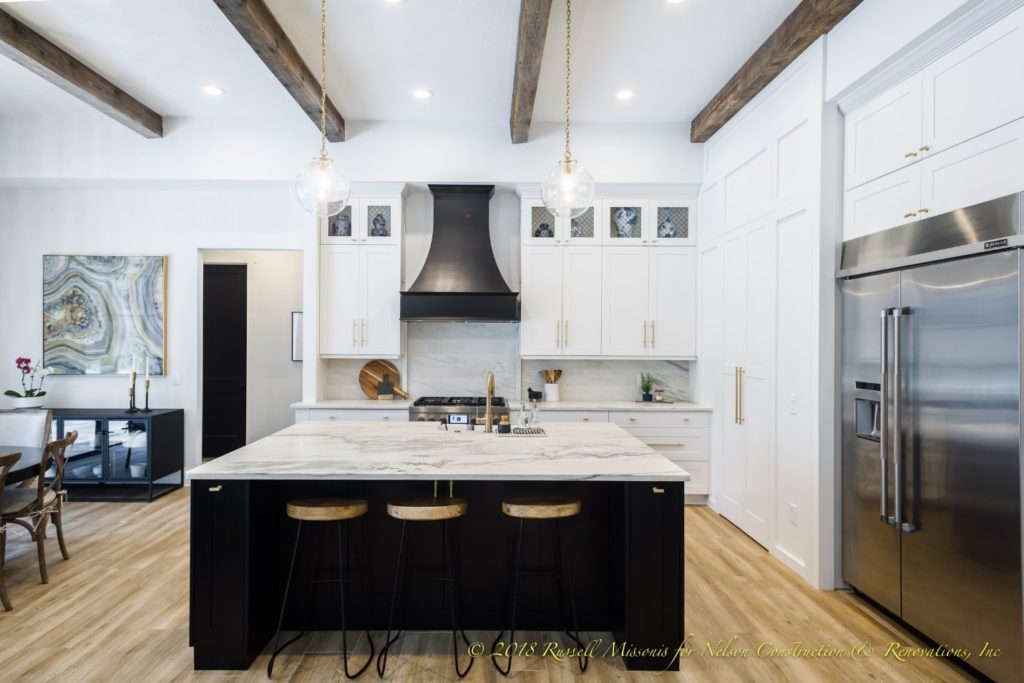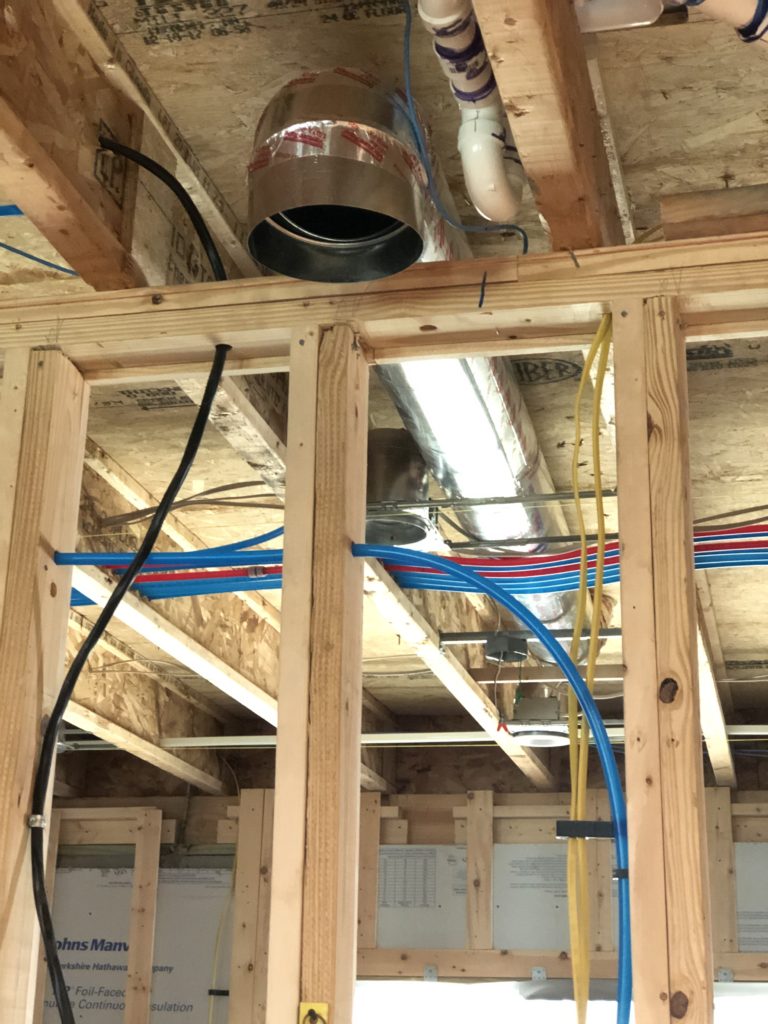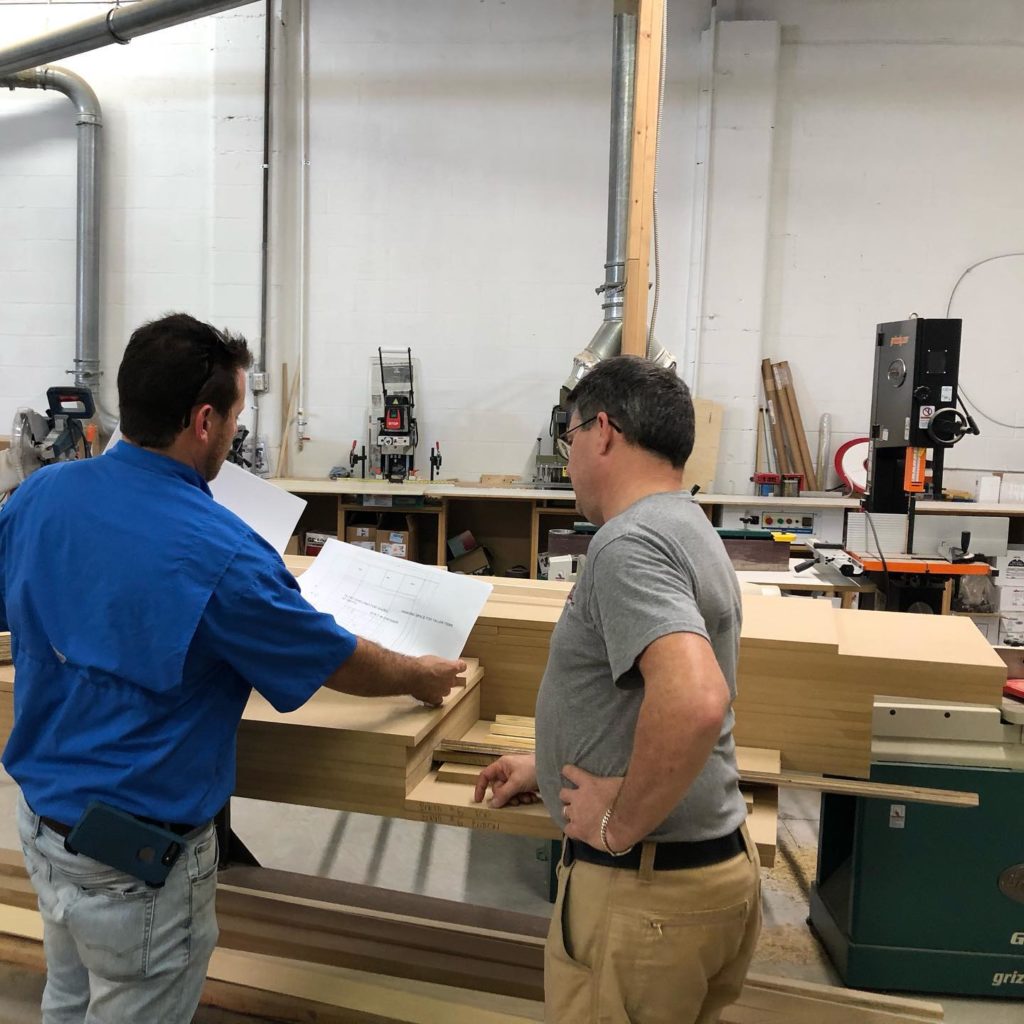
The custom range hood of this black-and-white kitchen in one of our custom home remodels is the perfect focal point for the room.
More and more homeowners are steering away from industrial-grade, stainless steel range hoods and are opting for custom millwork to complete their kitchens. If your stove is the focal point of your kitchen, then the range hood should complement it accordingly. But installing a custom range hood is not just a matter of building a wood box and painting it. As in all things construction, you can’t forget about the logistics behind the finish piece, and that often involves multiple trades. Here are a few tips to help you when considering a custom range hood for your kitchen.
You Need a Hood Liner Insert
When creating a custom range hood, you are not going to be using a standard range hood fan. You are looking for something called a hood liner. This is a specific piece of hardware designed for those building a custom range hood. Most appliance stores sell these separately. You do not necessarily have to find a hood liner to match your range, since the liner will be covered up by millwork. You just need to make sure it includes all the features you want, and that the dimensions match the width of your range.
You Need to Know What Size Duct Your Home Needs
The air duct that runs from your hood to the exterior of your home needs to be a specific diameter, in order to account for the amount of air flow which will be affecting it. Ventilation power is measured in cubic feet per minute, also known as CFM. Every range hood has a different CFM, which depends on a variety of factors:
- How many BTU’s of heat your stove uses. BTU stands for British Thermal Unit and refers to the amount of energy required to increase the temperature of a pound of water by 1 degree Fahrenheit. Every product generates a different quantity of BTU’s, depending on its size, the number of burners, whether it has a grill, and so on. Essentially it is going to depend on how much heat your stove generates. If you have a heavy-duty, industrial-grade range, for instance (such as Wolf, Viking, top-of-the-line GE, Thermador, etc.), you are likely to have higher BTU’s. Thus, you will need a larger duct in order to remove the higher levels of exhaust fumes.
- How many turns your duct has to make when it is installed. We all know that the shortest distance between two points is a straight line. However, what if your line has to be bent and turned half a dozen times in order to make it through wall cavities, up through a second and third story, and out the roof? Your exhaust fumes are going to have a much longer journey out of the kitchen. Therefore, you will need a larger-diameter duct (higher CFM) in order to help the fumes escape.

This 8-inch diameter duct has been installed in this ceiling cavity in preparation for a custom hood over a gas range.
- How much heavy cooking you will be doing. If you are at professional chef status in your home, and that stove is going to be generating a lot of steam and/or strong smells, then you will need a larger duct size in order to prevent grease build-up in your kitchen.
- The size of your kitchen. Yes, it’s true – the size of your kitchen does affect the size of the air duct in your range hood. Larger kitchens contain more air to circulate through the space, which requires stronger fans.
- Whether your stove is electric or gas.
An electric stove typically calculates its CFM based on the width of the range. To guide you, consider that you will need roughly 100 CFM for every 10” of width on your electric range. So if your stove is 42”, you will need at least 420 CFM.
A gas stove, on the other hand, is a bit more complicated. They produce a lot more fumes and a lot more heat than an electric stove, so they require higher CFM’s. When searching for a gas range, look for the number of BTU’s advertised in the product information. It is usually given as the per-burner BTU (typically somewhere between 400 and 18,000 BTU’s). Simply add up the BTU output of each burner and divide by 100. That will give you the correct CFM requirement for your range. For instance, if the total amount of BTU’s on a cooktop was 45,000, then you would need a range hood with at least 450 CFM.
The best way to ensure you are purchasing a hood liner with the correct CFM is to consult with an HVAC contractor (or your general contractor) before ordering. Your HVAC contractor knows how to ensure he installs the correct size duct for your range.
Design and Build the Right-Sized Box
Now that you’ve removed the old cabinets or hood from above your range, installed the correct ducts, and installed the right hood liner for your stove, you are ready to build the custom range hood. Remember to design your custom hood before you build it! Now you can flex your carpentry skills and build the box in the right shape and size, then trim it out with finish pieces to match your cabinets. Caulk and fill nail holes, paint or stain your hood, and suddenly, your kitchen will be totally transformed!

Greg Nelson, Building Contractor, and Kevin, our Senior Cabinet Maker, go over designs for a custom range hood at our shop
For more information on construction, construction tips, renovating, remodeling, home additions, design-build and design tips subscribe to our YouTube Channel today!
Nelson Construction and Renovations, a family business founded in 2006, is a design-build company that specializes in high-end remodels, home additions, and custom homes. With our headquarters in Clearwater, Florida, we serve homeowners all over Pinellas and Hillsborough Counties. We are an award-winning member of the National Association of the Remodeling Industry and have an A+ rating with the Better Business Bureau.
Creative Commons Attribution: Permission is granted to re-post this article in its entirety with credit to Nelson Construction and a clickable link back to this page.
"Reliable, Licensed & Insured Building Contractor"
For A NO Obligation Design Consultation
Contact Us

 Loading
Loading 





